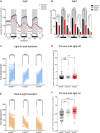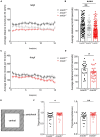Deleterious Variation in BR Serine/Threonine Kinase 2 Classified a Subtype of Autism
- PMID: 35754711
- PMCID: PMC9231588
- DOI: 10.3389/fnmol.2022.904935
Deleterious Variation in BR Serine/Threonine Kinase 2 Classified a Subtype of Autism
Abstract
Recently, deleterious variants in the BR serine/threonine kinase 2 (BRSK2) gene have been reported in patients with autism spectrum disorder (ASD), suggesting that BRSK2 is a new high-confidence ASD risk gene, which presents an opportunity to understand the underlying neuropathological mechanisms of ASD. In this study, we performed clinical and neurobehavioral evaluations of a proband with a de novo non-sense variant in BRSK2 (p.R222X) with other reported BRSK2 mutant patients. To validate BRSK2 as an ASD risk gene, we generated a novel brsk2b-deficient zebrafish line through CRISPR/Cas9 and characterized its morphological and neurobehavioral features as well as performed molecular analysis of neurogenesis-related markers. The proband displayed typical ASD behaviors and language and motor delay, which were similar to other published BRSK2 mutant patients. Morphologically, brsk2b -/- larvae exhibited a higher embryonic mortality and rate of pericardium edema, severe developmental delay, and depigmentation as well as growth retardation in the early developmental stage. Behaviorally, brsk2b-/- zebrafish displayed significantly decreased activity in open field tests and enhanced anxiety levels in light/dark tests and thigmotaxis analysis. Specifically, brsk2b-/- zebrafish showed a prominent reduction of social interaction with peers and disrupted social cohesion among homogeneous groups. Molecularly, the mRNA expression levels of homer1b (a postsynaptic density scaffolding protein), and mbpa, mpz, and plp1b (molecular markers of oligodendrocytes and myelination) were increased in the brain tissues of adult brsk2b-/- zebrafish, while the expression level of isl1a, a marker of motor neurons, was decreased. Taken together, for the first time, we established a novel brsk2b-deficient zebrafish model that showed prominent ASD-like behaviors. In addition, the disturbed mRNA expression levels of neurogenesis-related markers implied that the processes of postsynaptic signaling as well as oligodendrocytes and myelination may be involved. This discovery may suggest a path for further research to identify the underlying neuropathological mechanisms between BRSK2 and ASD.
Keywords: BRSK2 gene; animal model; autism spectrum disorder; neurodevelopment; social preference; zebrafish.
Copyright © 2022 Deng, Wang, Hu, Lin, Li, Liu and Xu.
Conflict of interest statement
The authors declare that the research was conducted in the absence of any commercial or financial relationships that could be construed as a potential conflict of interest.
Figures









Similar articles
-
Case report: A novel frameshift mutation in BRSK2 causes autism in a 16-year old Chinese boy.Front Psychiatry. 2023 Aug 21;14:1205204. doi: 10.3389/fpsyt.2023.1205204. eCollection 2023. Front Psychiatry. 2023. PMID: 37671287 Free PMC article.
-
Dynamic Regulation of brsk2 in the Social and Motor Development of Zebrafish: A Developmental Behavior Analysis.Int J Mol Sci. 2023 Nov 19;24(22):16506. doi: 10.3390/ijms242216506. Int J Mol Sci. 2023. PMID: 38003696 Free PMC article.
-
CRISPR/Cas9-induced shank3b mutant zebrafish display autism-like behaviors.Mol Autism. 2018 Apr 2;9:23. doi: 10.1186/s13229-018-0204-x. eCollection 2018. Mol Autism. 2018. PMID: 29619162 Free PMC article.
-
Zebrafish models of autism spectrum disorder.Exp Neurol. 2018 Jan;299(Pt A):207-216. doi: 10.1016/j.expneurol.2017.02.004. Epub 2017 Feb 3. Exp Neurol. 2018. PMID: 28163161 Review.
-
Developing zebrafish models of autism spectrum disorder (ASD).Prog Neuropsychopharmacol Biol Psychiatry. 2014 Apr 3;50:27-36. doi: 10.1016/j.pnpbp.2013.11.014. Epub 2013 Dec 6. Prog Neuropsychopharmacol Biol Psychiatry. 2014. PMID: 24315837 Review.
Cited by
-
In Search of a Target Gene for a Desirable Phenotype in Aquaculture: Genome Editing of Cyprinidae and Salmonidae Species.Genes (Basel). 2024 Jun 1;15(6):726. doi: 10.3390/genes15060726. Genes (Basel). 2024. PMID: 38927661 Free PMC article. Review.
-
Genomic analysis of 116 autism families strengthens known risk genes and highlights promising candidates.NPJ Genom Med. 2024 Mar 22;9(1):21. doi: 10.1038/s41525-024-00411-1. NPJ Genom Med. 2024. PMID: 38519481 Free PMC article.
-
Redox Regulation of Brain Selective Kinases BRSK1/2: Implications for Dynamic Control of the Eukaryotic AMPK family through Cys-based mechanisms.bioRxiv [Preprint]. 2024 Apr 10:2023.10.05.561145. doi: 10.1101/2023.10.05.561145. bioRxiv. 2024. Update in: Elife. 2025 Apr 02;13:RP92536. doi: 10.7554/eLife.92536. PMID: 38586025 Free PMC article. Updated. Preprint.
-
Whole genome analysis of rare deleterious variants adds further evidence to BRSK2 and other risk genes in Autism Spectrum Disorder.Res Sq [Preprint]. 2023 Oct 28:rs.3.rs-3468592. doi: 10.21203/rs.3.rs-3468592/v1. Res Sq. 2023. Update in: NPJ Genom Med. 2024 Mar 22;9(1):21. doi: 10.1038/s41525-024-00411-1. PMID: 37961520 Free PMC article. Updated. Preprint.
-
Case report: A novel frameshift mutation in BRSK2 causes autism in a 16-year old Chinese boy.Front Psychiatry. 2023 Aug 21;14:1205204. doi: 10.3389/fpsyt.2023.1205204. eCollection 2023. Front Psychiatry. 2023. PMID: 37671287 Free PMC article.
References
-
- Albadri S., De Santis F., Di Donato V., Del Bene F. (2017). “CRISPR/Cas9-Mediated Knockin and Knockout in Zebrafish,” in Genome Editing in Neurosciences, eds Jaenisch R., Zhang F., Gage F. (Cham: Springer; ), 41–49. - PubMed
LinkOut - more resources
Full Text Sources
Molecular Biology Databases

